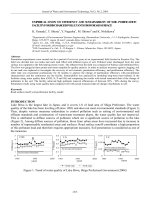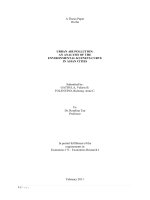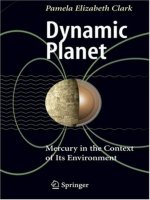Conservation of soil environment
Bạn đang xem bản rút gọn của tài liệu. Xem và tải ngay bản đầy đủ của tài liệu tại đây (86.61 KB, 4 trang )
32
Conservation of Soil Environment
1. Countermeasures for Soil Pollution
Since soil plays important roles such as filtration of water
quality, groundwater, recharge and production of foods, it is
indispensable to protect the soil from contamination and conserve
it in proper manner.
(1) Environmental quality standards for soil pollution
The soil, together with the water and air, is a key component
of the environment and plays an important role as basis for living
things including human beings and as integral part of the material
cycle. Once the soil is contaminated, the impacts last for a long
period.
Therefore, environmental quality standards are presently
defined for 27 items based on the Basic Environment Low. These
standards are standards compliance with which is desirable in
terms of protecting human health and conserving living
envirouments, and reviewed according to the accumulated
scientific data on the "as-necessary" basis.
The soil environmental quality standards stipulate the elution
standard aiming at filtration of water quality and purification of
groundwater, and the farmland standard aiming at conservation of
food production functions. These two standards are used to judge
whether the soil is contaminated or not and give targets for
designing the countermeasures against the pollution.
■ Environmental Quality Standards for Soil Pollution
Item Environmental quality standards
cadmium 0.0lmg/ in sample solution and less* than 1mg/kg in rice for agricultural land
total cyanide not detectable in sample solution
organic phosphorus** not detectable in sample solution
lead 0.0lmg/ or less* in sample solution
chromium (VI) 0.05mg/ or less* in sample solution
arsenic 0.0lmg/ or less* in sample solution, and less than 15mg/kg in soil for agricultural land
(paddy field only)
total mercury 0.0005mg/ or less* in sample solution
alkyl mercury not detectable in sample solution
PCB not detectable in sample solution
copper less than 125mg/kg in soil for agricultural land (paddy field only)
dichloromethane 0.02mg/ or less in sample solution
carbon tetrachloride 0.002mg/ or less in sample solution
1,2-dichloroethane 0.004mg/ or less in sample solution
1,1-dichloroethylene 0.02mg/ or less in sample solution
cis-1,2-dichloroethylene 0.04mg/ or less in sample solution
1,1,1-trichloroethane 1mg/ or less in sample solution
1,1,2-trichloroethane 0.006mg/ or less in sample solution。
trichloroethylene 0.03mg/ or less in sample solution
tetrachloroethylene 0.0lmg/ or less in sample solution
1,3-dichloropropene 0.002mg/ or less in sample solution
thiram 0.006mg/ or less in sample solution
simazine 0.003mg/ or less in sample solution
thiobencarb 0.02mg/ or less in sample solution
benzene 0.0lmg/ or less in sample solution
selenium 0.0lmg/ or less* in sample solution
fluorine 0.8mg/ or less* in sample solution
boron 1mg/ or less* in sample solution
* When involving those environmental limits concerning the concentration of cadmium, lead, chromium(VI), arsenic, total mercury, selenium
fluorine, or boron in liquid samples, when the soil contamination is alway from the groundwater level and the concentration of the substance
dose not exceed 0.01mg, 0.01mg, 0.05mg, 0.01mg, 0.0005mg, 0.01mg, 0.8mg, or 1mg, respectively, in the original condition, then the limit per
1 liter of liquid sample shall be 0.03mg, 0.03mg, 0.15mg, 0.03mg, 0.0015mg, 0.03mg, 2.4mg and 3mg respectively.
** Organic phosphorus means parathion, methylparathion, methyldimeton, and EPN.
Note: The above standards are not applicable to (1) the soil in those places where natural toxic substances exist such as the vicinities of mineral
veins and (2) the soil in those places designated for storage of toxic materials such as waste disposal sites with respect to the items listed
in the above table.
33
(2) Agricultural land soil pollution control measures
The soil pollution is one of the oldest pollution types and the
agricultural land soil pollution in the Watarase River Basin area
generated social concern around 1877. In 1968 "Itai-Itai disease"
in the Jinzu River Basin area proved to be a case of chronic
cadmium poisoning and again generated social concern to the
agricultural land soil pollution problem. Finally, in 1970 the
Agricultural Land Soil Pollution Prevention Law was enacted and
remedial projects by methods such as clean soil dressing were
initiated.
Cancellation of
designated
special area
Implementation of special
land improvement work
for environmental pollution
prevention/removal
Cancellation of designated
agricultural land
soil pollution policy areas
Planning of
cost-bearing plan
(Pollution Control Public Works
Cost Allocation Law)
Request for Application of
Financial Special Measures Law
(Law on Special Financial
Arrangement by the Government for
Public Pollution Control Projects)
Implementation of
measures against polluters
・ Water Pollution Control Law
・ Air Pollution Control Law
・ Mining Safety Law
・ Law on Special Measures for
Mine Damages Caused by the
metal mining industry, etc.
Designation of
special area
Implementation of
Survey of Policy Area
Planning of agricultural
land soil pollution
policy project
- Detailed survey for planning countermeasures
- Survey for confirming the result of project
Prefecture (Subsidy of MOE)
Prefectures (Subsidy of MOE)
Prefectures, municipalities
(Subsidy of MAFF)
Prefecture (Subsidy of MOE)
Prefectural Governors: Article 8 of the Law
Prefectural Governors: Article 9 of the Law
Prefectural Governors: Article 4 of the Law
Prefectural Governors: Article 5 of the Law
Prefectural Governors: Article 3 of the Law
Consent of Minister of the environment
and Minister of agriculture, forestry and fisheries
Report to
Minister of the environment
[Agricultural Land Soil Pollution Prevention Law]
(Law No.139 of December 25, 1970)
Central Environment
Council
Possible polluted area
(Inquiry) (Report)
(1) Designation of specific
harmful substances
(Cd, Cu, As)
(2) Establishment of
requirements for
designation of
policy areas
Designation of
agricultural land
soil pollution policy areas
Fact-finding survey of
possible polluted area
Fact-finding survey
of soil pollution
Surveillance and monitoring
for recurrence of pollution
Report to
Minister of the environment
Recommendation for planning of specific farm products
■ System of Implementing Agricultural Land Soil Pollution Control Measures
34
■ Progress in Recognizing and Restoring Sites
(3) Urban type soil pollution control measures
In 1975, a large quantity of soil contamination with
hexavalent chromium was found in Tokyo and it became a serious
social problem. Since then, the number of so-called "urban" type
soil pollution cases discovered has been rapidly increasing
throughout Japan mainly due to accelerated urban redevelopment
of sites such as those of former factories and the installation of
groundwater quality monitoring activities required by the Water
Pollution Control Law. The major soil polluters are the chemical
and electroplating industries and the major contaminants are lead,
arsenic, and trichloroethylene.
■ Discovered Number of Urban Type Soil Pollution Cases
(1) Area of site exceeding EQS 7,156ha
(2) Designated site area 6,266ha
(3) Planned site area
6,181ha
(4) Restored site area 5,818ha
(5) Area to be cleaned in the future
1,338ha
(ha)
'70 '71 '72 '73 '74 '75 '76 '77 '78 '79 '80 '81 '82 '83 '84 '85 '86 '87 '88 '89 '90 '91 '92 '93 '94 '95 '96 '97 '98 '99 '00 (FY)
0
20
40
60
80
100
120
140
160
180
200
Establishment of soil
environment standards
Number of events
exceeding the standards
Number of
survey events
Addition of soil
environment
standard items
FY
O
n and
before 1974
'75
'76
'77
'78
'79
'80
'81
'82
'83
'84
'85
'86
'87
'88
'89
'90
'91
'92
'93
'94
'95
'96
'97
'98
'99
Number of survey events
2 7 6 2 10 5 3 10 2 17 10 18 12 16 23 20 26 38 34 43 44 44 56 58 197 183
Number of events
exceeding the standards
−−−−−− − − −− −− − − − −− 8
12 13 26 36 50 47 122 117
Number
of
events
35
■ Number of Events Exceeding the Standards Per Substance (Accumulation)
2. Survey and Policy Planning of Soil and
Groundwater Pollutions
With respect to the soil pollution (caused by the pollutants
except for dioxins) in the urban area, the business owners have
been taking voluntary activities according to the Survey and
Countermeasure Guidelines for Soil and Groundwater
Countamination enacted in January 1999.
Each business owner is required to survey the soil whenever it
modifies the land properties and, if it is proved that the soil fails
to comply with the environmental quality standards, take any
necessary action so that the soil will meet the standards.
120
102
64
55
29
28
15
7
1
140
110
79
17
16
14
13
10
9
7
2
0
20
40
60
80
100
120
140
160
Elution standard item
Number of events
Heavy metals
VOC
Lead
Arsenic
Chromium (VI)
Total mercury
Cadmium
Total cyanide
Selenium
PCB
Thiobencarb
Trichloroethylene
Tetrachloroethylene
Cis-1,2-dichloroethylene
1,1-dichloroethylene
Carbon tetrachloride
1,2-dichloroethane
1,1,1-trichloroethane
Benzene
Dichloromethane
1,1,2-trichloroethane
1,3-dichloropropene
Discovery of pollution
Document survey of subject area (fact-finding)
Prefectural governments
General Survey of subject area
Countermeasures Guidance
Detailed survey of subject area
Report
Guidance
Guidance
Guidance
Guidance
(Temporary measures is needed when permanent measures cannot be taken immediately)
■
Outline of Technical Guideline of the Ministry of Environment
(Survey and Guideline Contermeasure for Soil and
Groundwater Contamination enacted in January 1999)
- The Ministry of Environment notifies prefectural governments of the
guidelines.
- Content
The Guideline stipulates the techniques on how to develop surveys
and countermeasures in handling of heavy metals (such as cadmium)
and volatile organic compounds (such as trichloroethylene) so that these
techniques will be helpful to implement surveys and countermeasures for
soil and groundwater pollutions.
(1) Survey procedure and evaluation of result
The Guideline defines three survey phases: document survey,
general survey, and detailed survey.
(2) Techniques
The Guideline describes the techniques for use in
countermeasures and summarizes their availability.
(3) Surrounding environment conservation and monitoring techniques
The Guideline describes the necessity of scattering and discharge
preventive measures and monitoring of surrounding groundwater.
(4) Communication with prefectural governments
If the land administrator discovers the pollution of soil and/or
groundwater through the voluntary survey, it shall report the fact to
the appropriate prefectural government(s).
(5) Preparation and control of records
The Guideline stipulates the necessity of preparing and controlling
the records which state the situation of pollution and
countermeasures.
■ Excavation of Polluted Soil
■ Flow of Guideline-based Survey and Countermeasures









